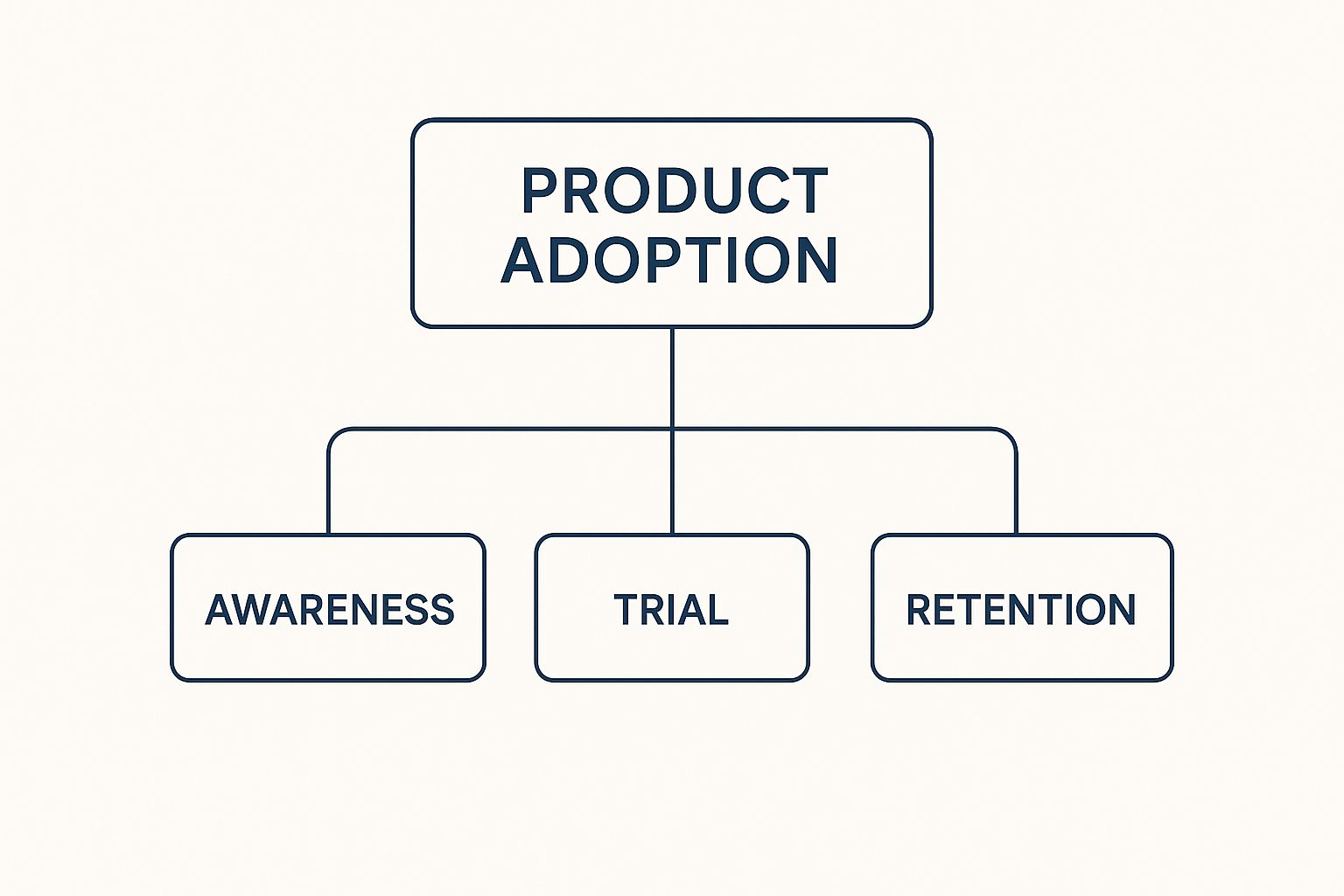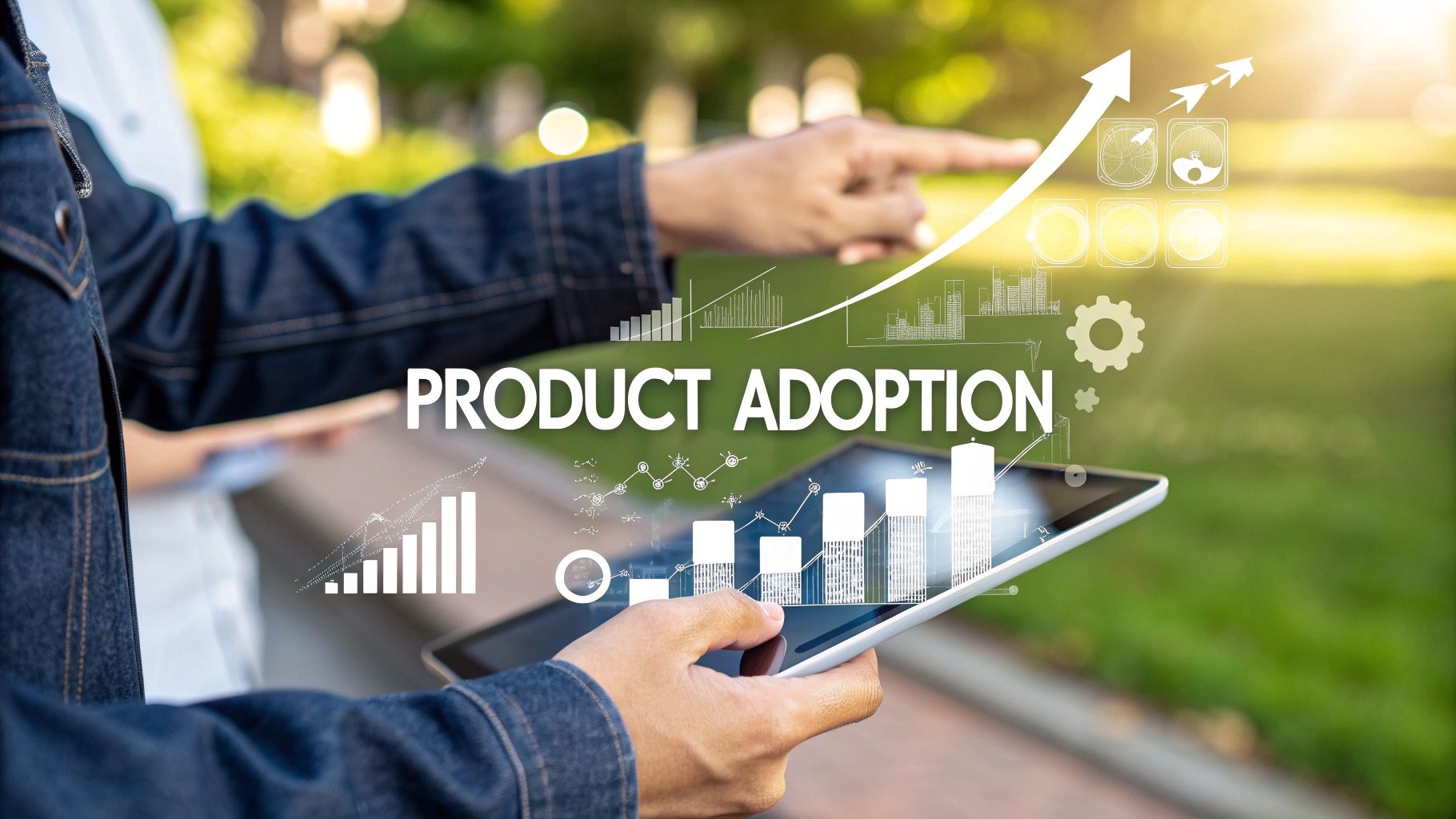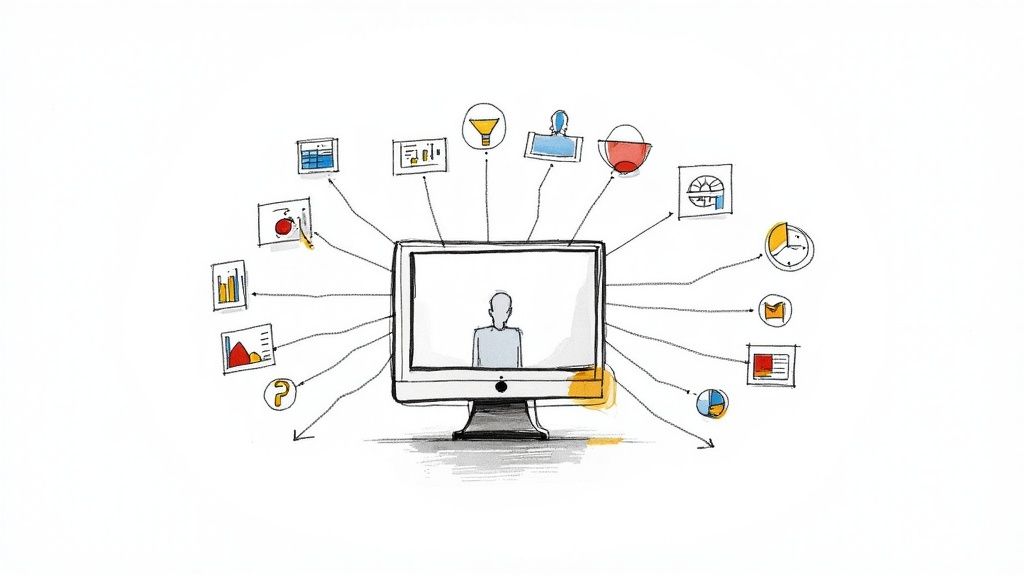What Is Product Adoption: A Complete Guide to Sustainable Growth
So, what is product adoption? Think of it as the complete journey a customer takes with your product, from the moment they first discover it to the point where it becomes an indispensable part of their daily life. It goes far beyond a one-time purchase or a quick sign-up. Product adoption is the process of a user becoming truly comfortable, proficient, and ultimately, a loyal advocate who sees real, ongoing value in what you offer.
Why Product adoption Is Your True North
Let’s use an analogy. Imagine you buy a fancy new smart home device. At first, you might just use it for the most basic function, like turning a light on and off with your voice. That’s acquisition.
But true adoption is what happens next. It's when you start setting up custom lighting routines for movie nights, connecting the device to your smart thermostat, and genuinely relying on it to make your life easier. At that point, the product has become deeply embedded in your daily habits.
This journey—from curious newcomer to devoted advocate—is the real test of a product's success. It’s a much deeper measure than just user acquisition. Getting a user in the door is one thing; adoption is convincing them to stay, make themselves at home, and tell all their friends how great it is.
More Than Just a Buzzword
Getting product adoption right has a massive, direct impact on your most critical business goals. When users fully embrace your product, they stick around. This is the engine that drives customer loyalty, higher retention rates, and sustainable, long-term revenue.
The benefits are clear and tangible:
- Boosts Customer Retention: Users who consistently get value from your product have no reason to leave.
- Increases Customer Lifetime Value (CLV): Adopted users are the ones who upgrade, add more seats, and explore your premium features.
- Creates Brand Advocates: Happy, successful users become your most powerful marketing channel, spreading the word organically.
The Science Behind How People Adopt New Things
This whole process is so fundamental that it’s been studied for decades. One of the most famous models is Everett Rogers' Diffusion of Innovations theory. He broke down the population into five groups based on how quickly they jump on new technology: innovators (2.5%), early adopters (13.5%), early majority (34%), late majority (34%), and laggards (16%).
This framework is incredibly helpful for understanding how new ideas and products ripple through society. If you're curious about how these classic patterns apply today, Bain & Company's latest report offers some fascinating insights into modern consumer trends.
As you can see below, the adoption journey is supported by several key pillars.

This visual really drives home the point: adoption isn't a single moment. It's a continuous process that builds from a user’s initial awareness all the way through to long-term retention.
The 4 Key Stages of the Product Adoption Journey
To really get a handle on this, it helps to break the user's journey down into distinct stages. Each one represents a different mindset and requires a different focus from your team.
Understanding these four stages helps you see product adoption not as a single event, but as a relationship you build with your users over time. Your job is to guide them from one stage to the next, clearing roadblocks and celebrating their progress along the way.
Navigating the Product Adoption Funnel
Product adoption doesn't happen all at once. It’s a journey, and the best way to visualize it is as a funnel. Think of potential users starting at the wide top and moving through distinct stages, each step bringing them closer to making your product an indispensable part of their routine.
Successfully guiding people through this process is how you turn a flicker of curiosity into loyal, habitual use.

This funnel isn't just a theoretical model; it's a practical map. It helps you understand what your users are thinking at every step and, just as importantly, lets you pinpoint exactly where they might be getting stuck and dropping off.
Let's walk through each of these critical phases.
From Discovery to Consideration
The journey starts long before anyone clicks "sign up." The first few stages are all about grabbing attention and convincing someone that your product is worth a serious look.
Awareness: This is the very top of the funnel. It's the first time a person even hears that your product exists. Maybe they stumble upon a blog post, see a targeted ad, or get a recommendation from a friend. At this point, they're just realizing they have a problem; they aren't necessarily looking for your solution yet. Your job is simply to make a strong first impression.
Interest: Now that they know about you, curiosity kicks in. They start actively digging for more information—visiting your website, reading up on features, maybe checking out a case study. Their thinking shifts from a passive "What is this thing?" to an active "Hmm, how could this actually help me?"
Evaluation: At this stage, things get serious. The user is actively weighing your product as a viable solution to their problem. They're comparing your features, pricing, and customer reviews against your competitors. They need to be convinced that your product is the right fit for their specific needs and that your company is a trustworthy choice.
Key Takeaway: The top of the funnel is a battle for attention and trust. Your marketing has to do more than just exist; it needs to clearly define the problem you solve and make a compelling case for why your solution is the best one on the market.
From Trial to True Adoption
Once you’ve convinced someone to give your product a shot, the spotlight shifts from your marketing to the actual in-product experience. This is the moment of truth where you either win them over for good or lose them forever.
Trial: The user takes the plunge and signs up for a free trial or a freemium version of your product. Think of this as your product's audition. It’s not enough to just open the doors and let them wander around. You have to create an experience that leads them straight to their "Aha!" moment—that magical instant where they personally feel the core value your product delivers.
Adoption: This is the ultimate goal. Adoption is when a user makes a conscious choice to weave your product into their daily life and workflow. They stop thinking like a trial user and become a committed, paying customer who relies on your tool out of habit.
- Activation Rate: What percentage of new users actually complete that one key action that makes them go, "Aha! I get it"? That’s activation. A high activation rate is a strong sign that your onboarding process is doing its job.
- Time to Value (TTV): How long does it take a brand-new user to experience that "Aha!" moment? The shorter the TTV, the better. When you prove your product's worth quickly, you drastically reduce the odds of a new user churning.
- Feature Adoption Rate: This one is simple but powerful. It tracks how many of your active users are actually engaging with a specific feature. If a core feature has a low adoption rate, that's a major red flag—it could signal anything from poor discoverability to a fundamental mismatch with what your users need.
- Personalize the Journey: No two users are alike. Kick things off with a simple welcome survey to understand their role or what they want to achieve. Then, steer them directly toward the features that will make their lives easier.
- Use Checklists: Onboarding checklists give new users a clear path forward. They slice a big, intimidating process into small, satisfying steps, creating a natural pull to see it through to the end.
- Prioritize the "Aha!" Moment: Pinpoint that one key action that delivers a burst of value. Now, design your entire onboarding flow to get users to that exact point as quickly and easily as possible.
- Painless Onboarding: They made it ridiculously simple for a merchant to get a store online or for a customer to buy something. The whole point was to get users to that first "win" as fast as possible.
- Building Rock-Solid Trust: Features we now take for granted, like customer reviews, secure payment systems, and clear return policies, were vital for getting people comfortable with buying things online.
- Always Adding Value: They never stopped improving. Things like one-click ordering and personalized recommendations kept making the experience better, turning a single purchase into a long-term habit.
- An Obvious Value Prop: They solved a very clear problem—creating text, code, or images—and wrapped it in a simple interface that anyone could use instantly.
- Seamless Integration: Most AI tools are built to slide right into the way people already work, using APIs and integrations that don't force users to change their habits.
- It doesn't just give a tour of features; it actively helps users solve their immediate problem.
- It guides them straight to their "Aha!" moment—that flash of insight where they personally feel the value your product delivers.
For instance, a project management tool like Asana doesn't achieve adoption when one person creates a single task. It happens when that person's entire team depends on it every single day to know who’s doing what and when. Each stage of the funnel requires a different strategy to reduce friction and keep the momentum going, turning a passive journey into an active engine for growth.
Measuring the Metrics That Truly Matter
If you want to get a real handle on product adoption, you have to look past gut feelings and dig into the data. It's simple: if you can't measure it, you can't improve it. The right metrics tell you the story of how people are actually using your product, showing you what’s working and, more importantly, where they’re getting stuck.

Tracking the right key performance indicators (KPIs) is how you turn vague goals into a clear action plan. This is what allows you to make smart, data-driven decisions that actually move the needle on user experience and business growth.
Core Metrics for Your Adoption Dashboard
It's easy to get lost in a sea of data. While you could track dozens of numbers, a handful of core metrics will give you the clearest picture of your adoption health. Focusing on these helps cut through the noise.
Here are the essentials you should be watching:
Think of these metrics as a team. A high Activation Rate is great, but if your TTV is slow, it means your onboarding is working but could be a lot more efficient. They tell a story together.
When you're ready to dig deeper, a structured view can make these concepts even clearer. Here's a breakdown of the key metrics you'll want to keep an eye on.
These metrics provide the foundation for a data-informed adoption strategy, helping you move from guesswork to targeted action.
Linking Adoption to Business Outcomes
At the end of the day, product adoption has to connect to the company's bottom line. This is where you tie everything back to financial and long-term engagement metrics. They’re the proof that your adoption efforts are creating sustainable revenue and building a loyal customer base.
A common mistake is focusing solely on initial engagement. True product adoption is measured by sustained, habitual use that creates long-term value for both the customer and the business.
One of the most critical metrics here is Customer Lifetime Value (CLV). This KPI isn't just a number; it's a prediction of the total revenue you can expect from a single customer over the entire course of your relationship.
When users truly adopt your product, they don't just use it—they stick around, upgrade their plans, and try out new features. All of these behaviors directly boost their CLV. For a closer look, you can explore proven strategies for increasing customer lifetime value and see how it all circles back to a strong adoption framework. Think of it this way: high adoption is the engine that drives a high CLV.
Proven Strategies to Drive Higher Adoption
Knowing your numbers is one thing, but actually doing something with that data is what separates a product people love from one that gathers dust. Driving higher product adoption isn't about luck; it's a deliberate, user-focused effort to guide people from "What's this?" to "I can't live without this." It's all about clearing roadblocks and proving your value, again and again.
The best strategies are built around creating a smooth and supportive experience right from the get-go. Picture it like rolling out a red carpet that leads new users straight to that "Aha!" moment where everything just clicks.
Design a Frictionless Onboarding Flow
Your user onboarding process is, without a doubt, the most critical factor in driving adoption. It's your product's first handshake, and it sets the stage for the entire relationship. A truly great onboarding experience doesn’t just walk someone through features—it helps them solve a real problem, fast.
Here’s how to get it right:
Take Miro, for example. The design tool doesn’t just dump you on a blank canvas and wish you luck. It serves up a whole library of templates for specific jobs, like brainstorming sessions or mapping a customer journey. This immediately flattens the learning curve and shows people how to get value out of the tool in seconds.
Leverage In-App Contextual Guidance
Okay, so your user is through the initial setup. The job isn't done. Real adoption requires ongoing support that helps people discover new functionality and get better at using your product over time. This is where contextual, in-app guidance comes in—it’s the perfect way to help without being annoying.
Key Insight: The best guidance feels less like an interruption and more like a helpful assistant showing up at the exact moment you need them.
This is why interactive product tours and tooltips are so effective. Instead of a generic, one-size-fits-all tour, you can trigger help based on what a user actually does. For instance, if a user clicks on an advanced feature for the very first time, a small tooltip can pop up to explain what it does. This approach respects their workflow while encouraging them to go deeper.
Many of today's most successful strategies are built around product-led growth, where the product itself becomes the main engine for acquiring and keeping customers. To see how this model works from the inside out, check out our complete guide on what is product-led growth.
Gamify the Experience and Reward Engagement
Making your product fun to use is another fantastic way to boost adoption. Gamification brings in elements like points, badges, and progress bars to motivate users and build positive habits. The language-learning app Duolingo is the master of this, using daily streaks and leaderboards to turn learning into a surprisingly addictive game.
Setting up reward systems is a great way to encourage the behaviors you want to see. This could be as simple as in-app recognition or as tangible as offering real-world benefits. The point is to show users you appreciate their time and effort. There are all sorts of creative ways to do this, from simple feature unlocks to more complex systems like rewarding community engagement to build a powerful, loyal following.
Learning from Product Adoption Success Stories
Theory is great, but there's nothing like seeing it in action. The best way to understand what drives successful adoption is to look at the products that have absolutely nailed it. By digging into how today's biggest names got where they are, we can pull out real, repeatable strategies. These stories aren't just about cool tech; they're masterclasses in understanding users and delivering value from day one.

Think of these examples as practical lessons you can steal for your own product. They show how different companies turned that first spark of interest into genuine, long-term loyalty.
The Rise of Digital Commerce Platforms
Take a look at the journey of e-commerce. Giants like Amazon and Shopify didn't just build websites; they created entire ecosystems built on trust and convenience. Their success came down to one thing: a relentless obsession with making things easier for the user.
Their strategy revolved around a few key pillars:
This laser focus on the user is a huge reason why an estimated 2.77 billion people around the world now shop online.
The Explosive Growth of AI Tools
More recently, the wild ride of AI tools like ChatGPT offers another incredible lesson in product adoption. Their meteoric rise wasn't just about having amazing technology; it was about making that technology incredibly accessible and immediately useful.
These AI platforms pulled off one of the fastest adoption cycles in history by doing a few things exceptionally well:
The big takeaway from the AI boom is all about speed to value. These tools showed that when a user gets that "wow" moment within seconds, adoption doesn't just happen—it explodes.
This approach has sparked unbelievable growth, with the global AI market projected to hit $1.81 trillion by 2030. It’s proof that when a product is both powerful and dead simple to use, the path to widespread adoption gets a whole lot shorter. Scaling that experience often involves smart automation. You can learn more about how to do that in our guide to customer success automation.
Your Product Adoption Questions Answered
Even with the best strategy in place, a few common questions about product adoption always seem to pop up. Let's clear up some of the usual points of confusion so you can move forward with total confidence.
What Is the Difference Between Product Adoption and User Acquisition?
Let's use a simple analogy. Think of user acquisition as getting someone to walk into your coffee shop for the first time. Product adoption is turning them into a regular who comes in every morning and knows the barista by name.
Acquisition is that initial, top-of-funnel moment—the signup, the download, the first login. It's a single event. But adoption is the whole journey that comes after. It’s the process of guiding that new user until your product becomes an indispensable part of their routine because it delivers so much value.
A business with high acquisition but low adoption is like a leaky bucket. You can pour customers in all day, but they'll just trickle right back out. Real, sustainable growth is always built on a solid foundation of adoption, not just a mountain of signups.
How Long Does the Product Adoption Process Take?
There’s no magic number here. The timeline for adoption completely depends on your product's complexity and the specific problem it solves for the user.
A simple consumer app might see a user "adopt" it within a few minutes. On the other hand, a complex enterprise platform like Salesforce could take a team weeks or even months to fully weave into their daily workflow.
The metric that matters most isn't the calendar; it's your Time to Value (TTV). This measures how fast a new user actually experiences the core benefit that brought them to you in the first place. Your goal should always be to shrink that TTV as much as possible with thoughtful design and a seamless onboarding flow.
What Is the Most Important Factor for Driving Product Adoption?
If you can only focus on one thing, make it the user onboarding experience. Those first few moments a user spends with your product are absolutely critical. They set the stage for everything that follows.
A truly great onboarding experience does two things exceptionally well:
Nailing that first impression is the single most powerful thing you can do to boost your adoption rate. It creates the momentum that turns a curious new user into a loyal advocate.
Ready to turn more visitors into loyal customers? Worknet.ai transforms user engagement with proactive, AI-powered chat that guides users from their first visit to full adoption. Discover how Worknet.ai can accelerate your growth.
FAQs
.png)
Lorem ipsum dolor sit amet, consectetur adipiscing elit. Suspendisse varius enim in eros elementum tristique. Duis cursus, mi quis viverra ornare, eros dolor interdum nulla, ut commodo diam libero vitae erat. Aenean faucibus nibh et justo cursus id rutrum lorem imperdiet. Nunc ut sem vitae risus tristique posuere.
Lorem ipsum dolor sit amet, consectetur adipiscing elit. Suspendisse varius enim in eros elementum tristique. Duis cursus, mi quis viverra ornare, eros dolor interdum nulla, ut commodo diam libero vitae erat. Aenean faucibus nibh et justo cursus id rutrum lorem imperdiet. Nunc ut sem vitae risus tristique posuere.
Lorem ipsum dolor sit amet, consectetur adipiscing elit. Suspendisse varius enim in eros elementum tristique. Duis cursus, mi quis viverra ornare, eros dolor interdum nulla, ut commodo diam libero vitae erat. Aenean faucibus nibh et justo cursus id rutrum lorem imperdiet. Nunc ut sem vitae risus tristique posuere.
Lorem ipsum dolor sit amet, consectetur adipiscing elit. Suspendisse varius enim in eros elementum tristique. Duis cursus, mi quis viverra ornare, eros dolor interdum nulla, ut commodo diam libero vitae erat. Aenean faucibus nibh et justo cursus id rutrum lorem imperdiet. Nunc ut sem vitae risus tristique posuere.
Lorem ipsum dolor sit amet, consectetur adipiscing elit. Suspendisse varius enim in eros elementum tristique. Duis cursus, mi quis viverra ornare, eros dolor interdum nulla, ut commodo diam libero vitae erat. Aenean faucibus nibh et justo cursus id rutrum lorem imperdiet. Nunc ut sem vitae risus tristique posuere.
Lorem ipsum dolor sit amet, consectetur adipiscing elit. Suspendisse varius enim in eros elementum tristique. Duis cursus, mi quis viverra ornare, eros dolor interdum nulla, ut commodo diam libero vitae erat. Aenean faucibus nibh et justo cursus id rutrum lorem imperdiet. Nunc ut sem vitae risus tristique posuere.
Lorem ipsum dolor sit amet, consectetur adipiscing elit. Suspendisse varius enim in eros elementum tristique. Duis cursus, mi quis viverra ornare, eros dolor interdum nulla, ut commodo diam libero vitae erat. Aenean faucibus nibh et justo cursus id rutrum lorem imperdiet. Nunc ut sem vitae risus tristique posuere.
Lorem ipsum dolor sit amet, consectetur adipiscing elit. Suspendisse varius enim in eros elementum tristique. Duis cursus, mi quis viverra ornare, eros dolor interdum nulla, ut commodo diam libero vitae erat. Aenean faucibus nibh et justo cursus id rutrum lorem imperdiet. Nunc ut sem vitae risus tristique posuere.
Lorem ipsum dolor sit amet, consectetur adipiscing elit. Suspendisse varius enim in eros elementum tristique. Duis cursus, mi quis viverra ornare, eros dolor interdum nulla, ut commodo diam libero vitae erat. Aenean faucibus nibh et justo cursus id rutrum lorem imperdiet. Nunc ut sem vitae risus tristique posuere.
Lorem ipsum dolor sit amet, consectetur adipiscing elit. Suspendisse varius enim in eros elementum tristique. Duis cursus, mi quis viverra ornare, eros dolor interdum nulla, ut commodo diam libero vitae erat. Aenean faucibus nibh et justo cursus id rutrum lorem imperdiet. Nunc ut sem vitae risus tristique posuere.

.svg)


.webp)
.webp)
.webp)





